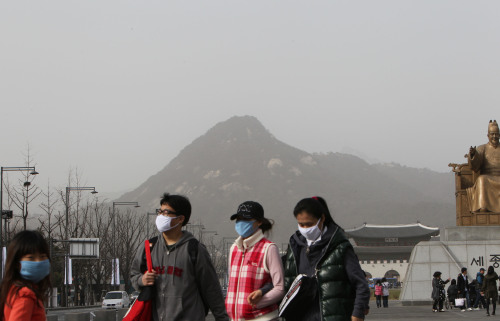Yellow dust from China contains radioactive substance: institute
By 양승진Published : March 20, 2011 - 11:34
Yellow dust blowing over South Korea every year from China is believed to contain radioactive materials presumed to have been leaked from nuclear power plants in the neighboring country, a state think tank said Sunday.
Small amounts of cesium-137, a highly radioactive material, have been detected in the air and surface of South Korea between February and April, when the dust gets most serious, over the past 10 years, the Korea Institute of Nuclear Safety said in a report submitted to an opposition lawmaker.

The hazardous dust usually sweeps South Korea in spring every year.
Yellow dust -- fine sand blown from China and Mongolia every spring that sometimes includes toxic chemical smog emitted by Chinese factories -- can cause respiratory disorders.
The atmospheric concentration of cesium-137 reached up to 252 becquerels per cubic meters, especially when the yellow dust continued for up to 11 days, the institute said. The most recent figure was 89.6 becquerels per cubic meters, a relatively high amount, measured for three days in March last year.
On Saturday, South Korea was put under the first yellow dust advisory of the year.
Because the substance mostly is a product of artificial nuclear fission, it usually does not occur in nature to any significant degree until nuclear weapons testing begins.
A cesium concentration of more than 50,000 becquerels per cubic meters is considered harmful to the human body.
However, the lawmaker warned that the cesium level could increase in the future because China is building more nuclear power plants.
"We need to prepare for the potential danger, learning from the massive earthquake in Japan," said Rep. Byun Jae-il of the main opposition Democratic Party (DP).
The magnitude-9.0 earthquake that devastated Japan's northeastern region on March 11 triggered blasts in three nuclear reactors at the Fukushima plant, raising fears that radiation from the area could affect other parts of the world.
(Yonhap News)
<한글 기사>
"중국發 황사에 방사성 물질 함유"
해마다 중국에서 우리나라로 건너오는 황사에 원전 등에서 유출됐을 것으로 추정되는 방사성 물질이 함유돼 있는 것으로 나타났다.
민주당 변재일(국회 교육과학기술위원장) 의원이 20일 교육과학기술부 산하 원자력안전기술원에서 입수한 자료에 따르면 최근 10년간 황사가 집중적으로 발생하는 2 ∼4월 공기와 지표상에는 방사성세슘(Cs-137)이 매년 검출됐다.
1-11일간 지속되는 황사 기간 공기 속 먼지인 `대기부유진' 내 Cs-137의 농도는 최대 252μ㏃(베크렐)/㎥까지 나왔다.
가장 근래의 기록인 작년 3월 사흘간 측정한 농도는 89.6μ㏃/㎥로, 비교적 높은 편에 속했다.
땅 위에 떨어진 먼지인 낙진에서 나온 Cs-137 농도의 경우 많게는 한 차례의 황 사 기간에 252m㏃/㎡가 검출됐다.
대기부유진을 기준으로 Cs-137 농도가 통상 5만μ㏃/㎥ 이상이면 인체에 해를 끼치는 것으로 알려지고 있어 이 같은 검출치는 건강에 유해한 수준은 못되는 것으로 파악됐다.
그러나 원전 시설을 늘려가고 있는 중국에서 서풍을 타고 방사성 물질이 건너온점을 간과해서는 안된다는 지적이다. 최근 원전 폭발로 방사능 공포에 휩싸인 일본의 사례를 교훈 삼아 다른 인접국에서 유사한 사태가 발생한 때를 가정해 대응 체계를 마련해야 한다는 것이다.
변 의원은 "우리나라에서 검출된 핵활동 생성물은 모래 먼지에 달라붙어 운송된 것으로 추정된다"며 "일본 사태를 타산지석으로 받아들이고 잠재된 위험에 대비해야 한다"고 말했다.







![[Graphic News] More Koreans say they plan long-distance trips this year](http://res.heraldm.com/phpwas/restmb_idxmake.php?idx=644&simg=/content/image/2024/04/17/20240417050828_0.gif&u=)
![[KH Explains] Hyundai's full hybrid edge to pay off amid slow transition to pure EVs](http://res.heraldm.com/phpwas/restmb_idxmake.php?idx=644&simg=/content/image/2024/04/18/20240418050645_0.jpg&u=20240419100350)





![[From the Scene] Monks, Buddhists hail return of remains of Buddhas](http://res.heraldm.com/phpwas/restmb_idxmake.php?idx=652&simg=/content/image/2024/04/19/20240419050617_0.jpg&u=20240419175937)

![[KH Explains] Hyundai's full hybrid edge to pay off amid slow transition to pure EVs](http://res.heraldm.com/phpwas/restmb_idxmake.php?idx=652&simg=/content/image/2024/04/18/20240418050645_0.jpg&u=20240419100350)

![[Today’s K-pop] Illit drops debut single remix](http://res.heraldm.com/phpwas/restmb_idxmake.php?idx=642&simg=/content/image/2024/04/19/20240419050612_0.jpg&u=)